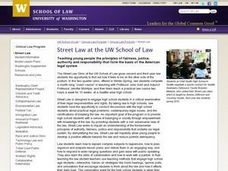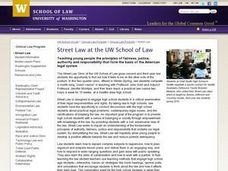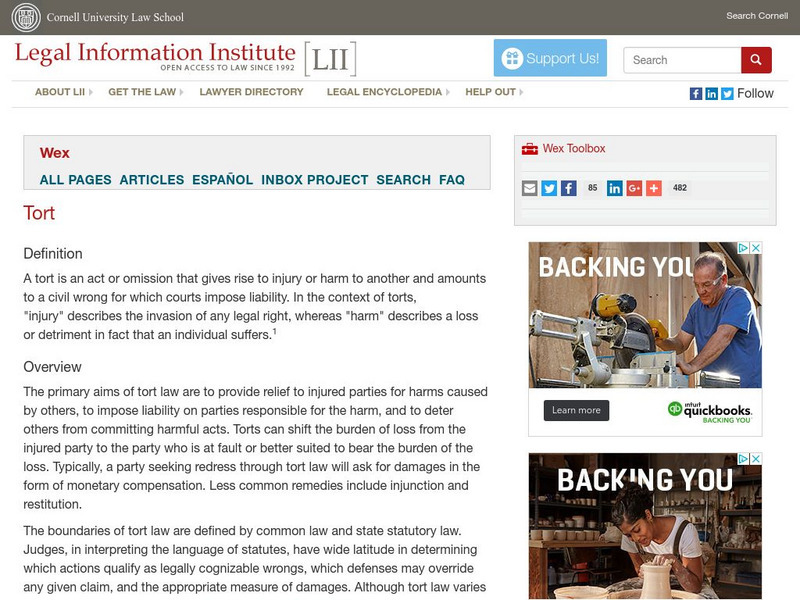Curated OER
Torts
Students examine tort law and defenses to negligence claims. They read case studies, participate in a mock trial, answer questions about the case summaries, and present information to their group about tort law.
Curated OER
Tort Law
Young scholars study the concept of negligence. They recognize the difference between civil and criminal law and examine the factors that courts consider when considering if there is a duty and whether it has been breached. They argue...
Curated OER
Torts (A/V)/Negligence/Damages
Students explore what it means to be responsible community members/citizens. They consider their duty to act as reasonable people under the circumstances and analyze a negligence case (duty, breach, damages). They detrmine their legal...
Curated OER
Tort Hypotheticals
Students review the use of intentional torts. In groups, they use specific statements and use them in hypothetical situtations. For each category, they write a statements about the situation and discuss them as a class. They complete a...
Curated OER
Tort Law -- Negligence
Students review the differences between criminal and civil law. In groups, they examine high-profile cases and identify any act of negligence. They create a list of the elements of negligence and answer discussion questions as they watch...
Curated OER
Torts: Intentional Torts
Students are introduced to the concept of intentional torts. In groups, they compare and contrast civil and criminal wrongs committed by people. They are given case studies and use the elements of torts to apply to them. They share their...
Curated OER
Tort Liability: Mock Trial
Students explore the trial process and the tort concept of host liability.
Curated OER
Law: Products Liability
Students examine the three theories of products liability and how tort law effects consumers. They investigate a case study and either represent the plaintiff or the defendant. After presenting their arguments, classmates vote as judges.
Curated OER
Toxic Torts
Twelfth graders examine the role of courts in environmental law enforcement. Using examples, they identify civil cases brought against large corporations for violating environmental laws. They define new vocabulary and discuss the...
School Improvement in Maryland
Court Proceedings Civil Cases
What's the difference between civil and criminal law? How do the court proceedings differ in these two types of trials? How do the standards of proof differ? Why do these differences exist? As part of their examination of the...
Wikimedia
Wikipedia: Negligence
Learn about negligence, which is "a type of tort or delict that can either be criminal or civil in nature." This encyclopedia entry explains the features of negligence claims, the types of damage awards victims may receive, and the legal...
Other
Law School help.com: Torts: Negligence
In addition to defining "negligence" and "tort," this article provides information on "negligence and ordinary care," "contributory negligence," "presumption of negligence," and related topics.
Other
Expert Law: Negligence and Tort Law
Written by lawyer Aaron Larson, this article provides simple definitions and explanations and is organized into the following sections: "Proximate Cause," "The Elements of Negligence Action," "Gross Negligence," "Children and...
Cornell University
Cornell University: Law School: Tort
At the Cornell Law School you can read a very simple definition of the legal term "tort" and read about the 1993 Supreme Court case "Smith v. United States."
Other
Law School help.com: Torts: Strict Liability
In addition to defining the terms "strict liability," "defendant," and "negligent," this website provides a detailed discussion on "products liability" and its place in the legal system.
Other
Law School help.com: Torts: Emotional Distress
Learn when and how a person can "Recover damages for the intentional and unreasonable infliction of mental or emotional distress." This website provides definitions for the following: "Emotional distress," "Severe," "Extreme and...
Other
Streetlaw: Torts
Chapters in this collection of online resources are "Torts: A Civil Wrong," "Intentional Torts," "Negligence," "Strict Liability," and "Torts and Public Policy." Provides links to both simple definitions and in-depth explanations of tort...
Other
Law School help.com: Torts: Fraud and Deceit
A good introduction to fraud and intentional torts, this website provides definitions of several terms including "Deceit," "Intentional misrepresentation," "Expression of opinion," "Concealment," "Nondisclosure of known facts," and...
Other
Law School help.com: Torts: Causation
When does negligence make a person liable for damage or injury? This website provides the answer to this question and defines the terms "cause" and "proximate cause."
Other
Law School help.com: Torts: Duty
Here is a definition of "duty" followed by a reference to and description of the case Palsgraf v. Long Island Railroad Co. Learn about the "duty of one in imminent peril" as well as the "responsibility of one causing the perilous...
Wikimedia
Wikipedia: Palsgraf v. Long Island Railroad Co.
Read about the New York Court of Appeals case "Palsgraf v. Long Island Railroad Co." (1928), the events that led up to the case, the final verdict, and how this case affected the legal system.
Other
Law School help.com: Palsgraf v. Long Island R. Co.
This website provides information on the New York court case "Palsgraf v. Long Island Railroad Company." Learn about the events that led to the trial as well as the outcome of the case.
Other
Ny State Judicial Ins: Palsgraf v. Long Island Railroad Company, Appellant
Learn about the historic New York trial "Palsgraf v. Long Island Railroad Company," and the appeal of its decision. Includes descriptions of events that led to the trial as well as details on the trial's outcome.

























